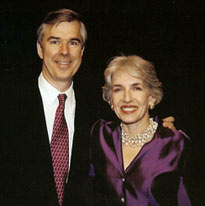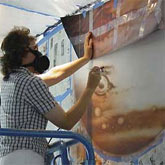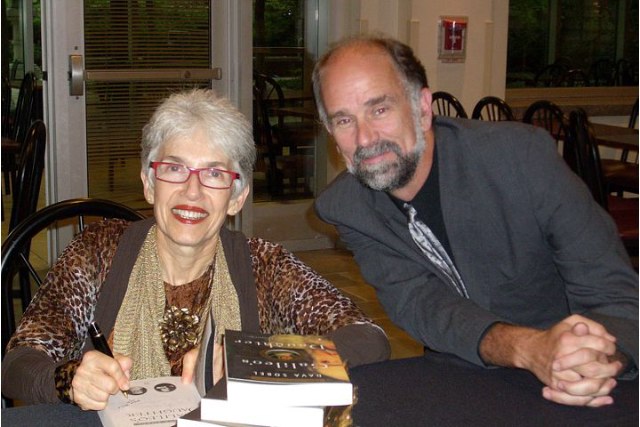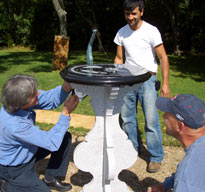 I may be the only writer in America who can honestly say, "I love my agent."Michael V. Carlisle has represented me for more than twenty years, and was happy to celebrate with me in 2001, when I received the Bradford Washburn Award from the Boston Museum of Science.
I may be the only writer in America who can honestly say, "I love my agent."Michael V. Carlisle has represented me for more than twenty years, and was happy to celebrate with me in 2001, when I received the Bradford Washburn Award from the Boston Museum of Science.
William J.H. Andrewes, who inspired my interest in longitude by the "Longitude Symposium" he organized in November 1993, has left his position as curator of Harvard University's Collection of Historical Scientific Instruments. He is now a consultant for museums and private collectors and has designed a unique form of sundial, called the Longitude Dial. Will Andrewes is shown (kneeling, left) with helpers installing the Garden Dial he made for me in a sunny spot in the back yard.
 My fellow eclipse-chasers David and Wendee Levy of the Jarnac Observatory in Vail, Arizona, paid me the ultimate compliment by petitioning the International Astronomical Union to name an asteroid in my honor. "1994 AK1," discovered by David with Carolyn Shoemaker on January 8, 1994 (the 352nd anniversary of Galileo's death) is now officially designated "30935 Davasobel." Wendee and David Levy are shown aboard the Ocean Monarch in the Aegean Sea, preparing to view the March 29, 2006 total solar eclipse.
My fellow eclipse-chasers David and Wendee Levy of the Jarnac Observatory in Vail, Arizona, paid me the ultimate compliment by petitioning the International Astronomical Union to name an asteroid in my honor. "1994 AK1," discovered by David with Carolyn Shoemaker on January 8, 1994 (the 352nd anniversary of Galileo's death) is now officially designated "30935 Davasobel." Wendee and David Levy are shown aboard the Ocean Monarch in the Aegean Sea, preparing to view the March 29, 2006 total solar eclipse.
 Lynette Cook is the space artist who created the twelve original images published in the paperback edition of The Planets. Lynette has also painted the discovery portraits of dozens of extrasolar planets — planets that orbit stars other than our Sun. Here is Lynette on a Michelangelo-style scaffold, painting a mural for the Downing Planetarium in Fresno, California.
Lynette Cook is the space artist who created the twelve original images published in the paperback edition of The Planets. Lynette has also painted the discovery portraits of dozens of extrasolar planets — planets that orbit stars other than our Sun. Here is Lynette on a Michelangelo-style scaffold, painting a mural for the Downing Planetarium in Fresno, California.
 Soprano Sarah Pillow had been singing seventeenth-century sacred and secular music for years before she read Galileo's Daughter, but now she includes dramatic readings of Suor Maria Celeste's letters in her concerts. She has even invited me to read letterson stage with her early music group, called "Galileo's Daughters." Here we are after our "Perpetual Motion" concert of November 28, 2005 at the Graduate Center of the City University of New York. On my right is lutenist Ronn McFarlane as Galileo's father, Vincenzo Galilei. Sarah stands next to me on my left, and to her left Mary Anne Ballard, who plays viola da gamba. Our photographer is Marc Wagnon, Sarah's jazz musician husband and the founder of Buckyball Music. Video.
Soprano Sarah Pillow had been singing seventeenth-century sacred and secular music for years before she read Galileo's Daughter, but now she includes dramatic readings of Suor Maria Celeste's letters in her concerts. She has even invited me to read letterson stage with her early music group, called "Galileo's Daughters." Here we are after our "Perpetual Motion" concert of November 28, 2005 at the Graduate Center of the City University of New York. On my right is lutenist Ronn McFarlane as Galileo's father, Vincenzo Galilei. Sarah stands next to me on my left, and to her left Mary Anne Ballard, who plays viola da gamba. Our photographer is Marc Wagnon, Sarah's jazz musician husband and the founder of Buckyball Music. Video.
 Composer Glenn McClure of Geneseo, New York, conceived an oratorio based on the letters of Galileo's daughter. The finished work, "The Starry Messenger," premiered May 20, 2006 in Rochester. Glenn's new project, "Galileo's Universe," engages school children in the process of opera composition.
Composer Glenn McClure of Geneseo, New York, conceived an oratorio based on the letters of Galileo's daughter. The finished work, "The Starry Messenger," premiered May 20, 2006 in Rochester. Glenn's new project, "Galileo's Universe," engages school children in the process of opera composition.
 While writing Galileo's Daughter, I received a great deal of insight and encouragement from Suor Maria Celeste's modern spiritual sisters at the Poor Clare Monastery of Our Lady of Guadalupe, in Roswell, New Mexico. I continued my correspondence with the abbess, Mother Mary Francis, P.C.C., until her death in 2005. Although she and I exchanged actual letters, not e-mail messages, the convent recently launched its own web site. Over the years, I was privileged to help build what is now the "Mother Mary Francis Memorial Library," consisting entirely of books chosen by the abbess for "higher studies" at the convent. With the advice of the new abbess, Mother Mary Angela, the library continues to grow by a book a month.
While writing Galileo's Daughter, I received a great deal of insight and encouragement from Suor Maria Celeste's modern spiritual sisters at the Poor Clare Monastery of Our Lady of Guadalupe, in Roswell, New Mexico. I continued my correspondence with the abbess, Mother Mary Francis, P.C.C., until her death in 2005. Although she and I exchanged actual letters, not e-mail messages, the convent recently launched its own web site. Over the years, I was privileged to help build what is now the "Mother Mary Francis Memorial Library," consisting entirely of books chosen by the abbess for "higher studies" at the convent. With the advice of the new abbess, Mother Mary Angela, the library continues to grow by a book a month.
 Bob Bonadurer, Director of the Daniel M. Soref Planetarium at the Milwaukee Public Museum, invited me to be the narrator of his International Year of Astronomy planetarium show, called "Galileo: The Power of the Telescope." On September 24, 2009, the night before the show opened, we gave the museum's trustees a sneak preview. The editorial staff of Astronomy Magazine, headquartered right nearby in Waukesha, Wisconsin, hosted a reception at the Museum beforehand. I enjoyed the 70-foot-high visuals, distracted though I was by the sound of my own voice reverberating through the theater like an angry god. Congratulations to Bob and his staff, and I hope other planetariums (or planetaria) will adopt our show.
Bob Bonadurer, Director of the Daniel M. Soref Planetarium at the Milwaukee Public Museum, invited me to be the narrator of his International Year of Astronomy planetarium show, called "Galileo: The Power of the Telescope." On September 24, 2009, the night before the show opened, we gave the museum's trustees a sneak preview. The editorial staff of Astronomy Magazine, headquartered right nearby in Waukesha, Wisconsin, hosted a reception at the Museum beforehand. I enjoyed the 70-foot-high visuals, distracted though I was by the sound of my own voice reverberating through the theater like an angry god. Congratulations to Bob and his staff, and I hope other planetariums (or planetaria) will adopt our show.

